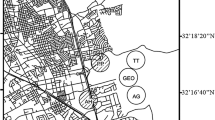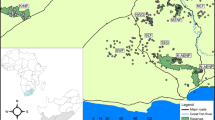Abstract
Genetic neighbourhood and effective population size (N e) are critical factors when determining the potential survival of threatened species. Carnivores have intrinsically small effective numbers, because, as top predators, they show low densities. The European mink, Mustela lutreola, is one of the most endangered carnivores in the world and has suffered continual decline and local extinctions. The genetic neighbourhood, area within which adults could randomly mate, averaged N a = 31.7 km diameter, allowing that population size within the neighbourhood area only ranged from N b = 6.1 to 22.8 animals. Although the population size was assessed in one of the main mink populations in the world, this neighbourhood size is far below the values regarded as critical in literature. However, in contrast with recent propositions, the ratio N e /N only ranged between 0.09 and 0.19, estimates close to the average recognised by Frankham [(1995) Genetic Research 66: 95–107] for wildlife populations. In the context of the challenge to conserve this endangered carnivore, the studied neighbourhood provided crucial information suggesting both a low neighbourhood size and severe disturbance of breeding exchanges, emphasising the dramatically threatened status of the European mink.
Similar content being viewed by others
Abbreviations
- N e :
-
effective population size
- N a :
-
genetic neighbourhood area
- N b :
-
population size within the genetic neighbourhood area
References
Allee W.C., Park O., Emerson A., Park T. and Schmidt K.P. 1950. Principles of Animal Ecology. Saunders Company, Philadelphia, Pennsylvania.
Amos W. and Harwood J. 1998. Factors affecting levels of genetic diversity in natural populations. Philosophical Transactions of the Royal Society B 353: 177–186.
Begon M., Krimba C.B. and Loukas M. 1980. The genetics of Drosophila subobscura populations. XV. Effective size of a natural population estimated by three independent methods. Heredity 45: 335–350.
Bekkevold D., Hansen M.M. and Loeschcke V. 2002. Male reproductive in spawning aggregations of cod (Gadus morhua, L.). Molecular Ecology 11: 91–102.
Bright P.W. and Smithson T.J. 2001. Biological invasions provide a framework for reintroductions: selecting areas in England for pine marten releases. Biodiversity and Conservation 10: 1247–1265.
Caro T.M. and Laurensen M.K. 1994. Ecological and genetic factors in conservation: a caution tale. Science 263: 485–486.
Driscoll D.A. 1999. Genetic neighbourhood and effective population size for two endangered frogs. Biological Conservation 88: 221–229.
Ellstrand N.C. and Elam D.R. 1993. Population genetic consequences of small population size. Implications for plant conservation. Annual Review of Ecology and Systematics 24: 217–242.
Frankham R. 1995. Effective population size/adult population size ratios in wildlife: a review. Genetic Research 66: 95–107.
Frankham R. 2003. Genetics and conservation biology. Comptes Rendus Biologies 326: S22-S29.
Frankham R., Ballou J.D. and Briscoe D.A. 2002. Introduction to Conservation Genetics. Cambridge University Press, Cambridge, UK.
Franklin I.R. 1980. Evolutionary changes in small populations. In: Soulé M.E. and Wilcox B.A. (eds) Conservation Biology: An Evolutionary-Ecological Perspective. Sinauer Press, Sunderland, Massachusetts, pp. 135–149.
Franklin I.R. and Frankham R. 1998. How large must populations be to retain evolutionary potential? Animal Conservation 1: 69–73.
Gadgil M. 1971. Dispersal: population consequences and evolution. Ecology 52: 253–260.
Garin I., Zuberogoitia I., Zabala J., Aihartza J., Clevenger A.P. and Rallo A. 2002. Home range of European mink (Mustela lutreola) in southwestern Europe. Acta Theriologica 47: 55–62.
Lacy R.C. and Lindenmayer D.B. 1995. A simulation study of the impacts of population subdivision on the mountant bushtail possum Trichosurus caninus Ogilby (Phalangeridae, Marsupiala) in southeastern Australia. 2. Loss of genetic variability within and between subpopulations. Biological Conservation 73: 131–142.
Lande R. 1995. Mutation and conservation. Conservation Biology 9: 782–791.
Lande R. and Barrowclough G.F. 1987. Effective population size, genetic variation, and their use in population management. In: Soulé M.E. (ed) Viable Populations for Conservation. Cambridge University Press, Cambridge, UK, pp. 87–123.
Lodé T. 1999. Genetic bottleneck in the threatened western population of European mink Mustela lutreola. Italian Journal of Zoology 66: 351–353.
Lodé T. 2001. Mating system and genetic variance in a polygynous mustelid, the European polecat. Genes and Genetic Systems 76: 221–227.
Lodé T. 2002. Endangered species as indicator for freshwater quality: a fractal diagnosis using fragmentation within European mink population. Archiv für Hydrobiologie 155: 163–176.
Lodé T., Cormier J.P. and Le Jacques D. 2001. Decline in endangered species as an indication of anthropic pressures: the case of European mink Mustela lutreola western population. Environmental Management 28: 727–735.
Lodé T., Berzins R. and Pereboom V. 2003. Implications of an individualistic lifestyle for species conservation: lessons from jealous beasts. Comptes Rendus Biologies 326: S30-S36.
Lynch M. and Lande R. 1998. The critical size for a genetically secure population. Animal Conservetion 1: 70–72.
Maran T. 1990. Conservation of the European mink in Estonia. Mustelid and Viverrid Conservation 2: 12.
Maran T. and Henttonen H. 1995. Why is the European mink (Mustela lutreola) disappearing? - a review of the process and hypotheses. Annales Zoologica Fennica 32: 47–54.
Maran T., Macdonald D.W., Kruuk H., Sidorovich V. and Rozhnov V.V. 1998. The continuing decline of the European mink Mustela lutreola: evidence for the intra-guild competition hypothesis. Symposium of Zoology of Society of London 71: 297–323.
Morris W., Doak D., Groom M., Kareira P., Fieberger J., Gerber L. et al. 1999. A Practical Handbook For Population Viability Analysis. The Nature Conservancy, Washington, DC.
Nunney L. 1993. The influence of mating system and overlapping generations on effective population size. Evolution 47: 1329–1341.
Nunney L. 1995. Measuring the ratio of effective population size to adult numbers using genetic and ecological data. Evolution 49: 389–392.
Nunney L. 1996. The influence of variation in female fecundity on effective population size. Biological Journal of the Linnean Society 59: 411–425.
Nunney L. and Elam D.R. 1994. Estimating the effective population size of conserved populations. Conservation Biology 8: 174–175.
O’Brien S.J. 1994. Genetic and phylogenetic analyses of endangered species. Annual Review of Genetics 28: 467–489.
Randi E. 2003. Conservation genetics of carnivores in Italy. Comptes Rendus Biologies 326: S54-S60.
Soulé M. 1976. Allozyme variation: its determinants in space and time. In: Ayala F.J. (ed) Molecular Evolution. Sinauer, Sunderland, Massachussetts, pp. 60–77.
Soulé M. 1987. Viable Populations for Conservation. Cambridge University Press, Cambridge, UK.
Waite T.A. and Parker P.G. 1996. Dimensionless life histories and effective population size. Conservation Biology 10: 1456–1462.
Weber D. 1989. Zur Populationsbiologie schweizerischer Iltisse (Mustela putorius L.). Zeitschrift für Jagdwiss 35: 86–99.
Wright S. 1969. Evolution and the Genetics of Populations. The Theory of Gene Frequencies. Vol. II. University of Chicago Press, Chicago, Illinois.
Zabala J. and Zuberogoitia I. 2003. Habitat use of male European mink (Mustela lutreola) during the activity period in south western Europe. Zeitschrift für Jagdwiss 49: 77–81.
Zabala J., Zuberogoitia I., Garin I. and Aihartza J.R. 2003. Landscape features in the habitat selection of European mink (Mustela lutreola) in south-western Europe. Journal of Zoology 260: 415–421.
Author information
Authors and Affiliations
Corresponding author
Rights and permissions
About this article
Cite this article
Lodé, T., Peltier, D. Genetic neighbourhood and effective population size in the endangered European mink Mustela lutreola . Biodivers Conserv 14, 251–259 (2005). https://doi.org/10.1007/s10531-005-5051-3
Received:
Accepted:
Issue Date:
DOI: https://doi.org/10.1007/s10531-005-5051-3




